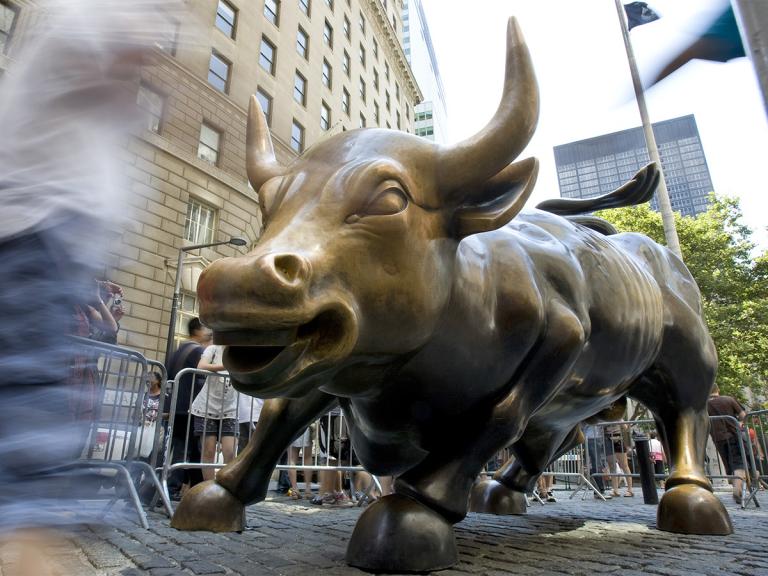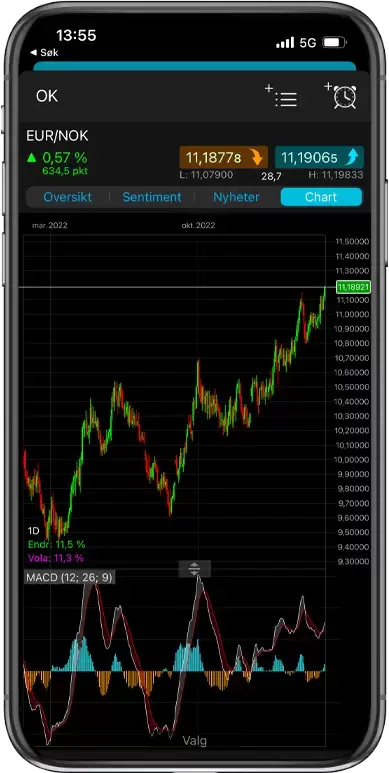The macro focus this week is set to be on Wednesday’s publication of minutes from the Federal Reserve’s recent meeting, and on Thursday’s revised estimate of US fourth-quarter GDP. Meanwhile, several FTSE 100-listed companies are due to report full-year earnings, including HSBC, Lloyds Banking Group and Rolls-Royce, among others listed in our table below.
WHAT’S MOVING MARKETS THIS WEEK?
Our pick of potentially market-moving economic and company events in the working week beginning 20 February:
Tuesday 21 February
HSBC full-year results
The rebound from the October low has sent HSBC shares to their highest levels since September 2019, driven by rising interest rates and optimism over a rebound in China’s economy in 2023.
When HSBC last reported, the shares fell back on news that Q3 revenue had fallen quarter-on-quarter to $11.6bn, while profits after tax fell to $2.56bn. Profit attributable to shareholders dropped to $1.9bn, down from $5.77bn in Q2, partly because HSBC increased provisions to cover non-performing loans. The bank set aside $1.1bn in Q3 – roughly equal to the amount it had set aside in Q1 and Q2 combined. In better news for investors, HSBC’s net interest margin beat expectations in Q3, rising to 1.57% from 1.35% in the previous quarter as the Bank of England raised the base rate.
In November, HSBC announced a deal to sell its Canadian business to Royal Bank of Canada for $10bn (£8.4bn) as the London-headquartered bank continues to shift its focus towards its core market of China. The move should help to appease activist shareholders, such as Chinese insurance firm Ping An.
The full-year results announcement may highlight an improving economic outlook in China, though performance in Q4 is still likely to have been negatively affected by the country’s coronavirus lockdowns, since restrictions were not lifted until December.
Wednesday 22 February
Fed minutes
The market reaction to the Federal Reserve’s quarter-point interest rate hike on 1 February highlighted a disconnect. Investors and the Fed appear at odds over the direction interest rates are likely to take this year, with the central bank pledging to “stay the course” in its fight against inflation and markets betting that the Fed will ease off. To borrow a line from the film Cool Hand Luke, “what we’ve got here is failure to communicate”.
Fed chair Jay Powell is partly responsible for this disconnect. At his press conference on 1 February, Powell insisted that more rate hikes were coming and said the Fed was not looking at rate cuts this year. But his failure to push back emphatically on direct questions about market expectations of rate cuts widened the gap between market pricing on rates and the Fed’s economic forecasts.
Since that meeting and press conference, several Fed officials have argued against the markets’ dovish narrative, vowing that rates will stay higher for longer. The meeting minutes should offer deeper insights into policymakers’ thinking on inflation and how long they expect rates to stay at current levels. However, it’s worth remembering that the meeting took place before the release of US services data and the jobs report, which showed that the US economy unexpectedly added 517,000 jobs in January. A key question that the minutes may answer is whether Fed officials stand by their December dot plot, which projected a year-end 2023 rate of 5.125%.
Lloyds Banking Group full-year results
Despite recovering from its October low, the Lloyds share price remains below its highs of last year. The shares are also down on pre-pandemic levels, having underperformed the FTSE 100 amid concerns over the bank’s heavy reliance on the UK, where it is the biggest mortgage lender. However, the bank has consistently increased profits in recent quarters. Lloyds is now more profitable than it was in 2019 when the shares were much higher.
In Q3 statutory pre-tax profits fell to £1.51bn, a 26% decline from the same quarter last year, and down by a similar percentage versus Q2. This was mainly because the bank set aside an extra £668m in provisions for non-performing loans, suggesting that the recent squeeze on customer finances was raising concerns within the bank about possible loan losses. Impairment provision in the first three quarters of the year came in at more than £1bn. The bank also reported that unsecured loan demand remained strong with a 4% increase to £ 8.8bn, while the open mortgage book increased 1%. This is expected to slow down in Q4 and in the new fiscal year.
Net interest margin (NIM) improved to 2.98% in Q3, up from 2.55% in Q2, pushing average NIM to 2.84% for the first nine months of the year. The group’s improved profitability has led to calls from politicians for a windfall tax on banks like Lloyds, even though profits are lower this year than they were last year. Lending to small business declined 3% to £39.8bn, which was unsurprising given the economic backdrop and the tax increases that are due to come into effect in April.
Thursday 23 February
US Q4 GDP
Although the Fed has raised its benchmark interest rate to a range of 4.5% to 4.75%, the US economy is holding up reasonably well, with strong growth in Q3 and Q4 last year after a weak first half.
The first estimate of fourth-quarter GDP last month put growth at 2.9%, above economists’ expectations of 2.5%. That followed an expansion of 3.2% in Q3. Consumer spending growth was a little disappointing at 2.1%, down from 2.3% in Q3, though this was hardly surprising given that retail sales contracted in November and December as shoppers stocked up early for the holiday season. Spending may have rebounded in January, with personal spending and income numbers due out soon.
Rolls-Royce full-year results
When Tufan Erginbilgic took over as CEO in January, he gave a brutal assessment of the challenges facing the business. Likening the company to a “burning platform” in a speech to Rolls-Royce employees, his words sent the shares lower after a rally had lifted them from less than 70p in September to 115p on 26 January, their highest level since February 2022. The company has its problems, with its heavy reliance on its civil aerospace division a notable weak spot, but even here there are grounds for optimism as airlines slowly return to their normal pre-Covid flying patterns.
In Q3 inventory levels were higher than they should have been as high demand for its power systems business led to record orders. Meanwhile, large engine flying hours were at the lower end of expectations, coming in at 65% of 2019 levels, despite the return of long-haul flights last year. The company said China’s zero-Covid policy had exerted a negative impact on its business, but this situation should improve in the coming months. Proceeds from the sale of ITP Aero were used to pay down a £2bn floating-rate loan.
As for the new fiscal year, investors may be hoping that Erginbilgic paints a more upbeat and optimistic picture of the company’s prospects than the assessment he offered last month.
Friday 24 February
US core PCE price index (January)
The Fed’s preferred measure of inflation, the core personal consumption expenditures (PCE) price index, fell to 4.4% in the year to December, down from from 5.2% in September. With the gauge easing to its lowest level since October 2021, a narrative of “disinflation” has buoyed markets and driven speculation that the Fed might cut interest rates before the end of 2023.
A further fall in the January reading of core PCE could help sustain the chatter around weakening price growth. Unfortunately for stock market bulls, however, a strong jobs report for January suggests that core PCE is unlikely to have fallen sharply. The US economy unexpectedly added 517,000 jobs in January, smashing economists’ forecasts of 185,000. Inflation could therefore remain relatively high, with prices potentially inflated by higher personal spending among those in work.
International Consolidated Airlines Group full-year results
Airlines have got off to flyer this year. Their shares have been buoyed by investor optimism that holidaymakers could return to the skies in what should be the first restriction-free year since Covid – at least in most tourist destinations. Budget airlines such as easyJet have reported a surge in bookings, which bodes well for larger carriers.
In Q3, British Airways owner International Consolidated Airlines Group [IAG] reported adjusted operating profits of €1.1bn, while revenue came in better than expected at €7.33bn, exceeding revenue in the corresponding quarter of 2019, despite operating at lower capacity. The increase in revenue was dure to higher ticket prices, with business travel at 75% of 2019 levels. Profit after tax in Q3 rose to € 853m. In the first three quarters of the year, IAG was back in the black to the tune of €170m.
For Q4, capacity was expected to rise to 87% of 2019 levels, with Q1 of the company’s new fiscal year expected to see a rise to 95%. That seems a little on the optimistic side, given the UK’s gloomy economic outlook. So far, only Ryanair has managed to return to those sorts of capacity levels.
INDEX DIVIDEND SCHEDULE
Dividend payments from an index's constituent shares can affect your trading account. View this week's index dividend schedule.
SELECTED COMPANY RESULTS
| MONDAY 20 FEBRUARY | RESULTS |
| Williams Companies (US) | Q4 |
| TUESDAY 21 FEBRUARY | RESULTS |
| Anglo American (UK) | Full-year |
| Caesars Entertainment (US) | Q4 |
| Coinbase Global (US) | Q4 |
| Home Depot (US) | Q4 |
| HSBC Holdings (UK) | Full-year |
| InterContinental Hotels Group (UK) | Full-year |
| La-Z-Boy (US) | Q3 |
| Molson Coors Beverage (US) | Q4 |
| Palo Alto Networks (US) | Q2 |
| Smith & Nephew (UK) | Full-year |
| Walmart (US) | Q4 |
| ZipRecruiter (US) | Q4 |
| WEDNESDAY 22 FEBRUARY | RESULTS |
| Bumble (US) | Q4 |
| Etsy (US) | Q4 |
| Lloyds Banking Group (UK) | Full-year |
| NVIDIA (US) | Q4 |
| Rio Tinto (UK) | Full-year |
| TJX Companies (US) | Q4 |
| Wingstop (US) | Q4 |
| THURSDAY 23 FEBRUARY | RESULTS |
| American Tower (US) | Q4 |
| BAE Systems (UK) | Full-year |
| Beyond Meat (US) | Q4 |
| Booking Holdings (US) | Q4 |
| Domino's Pizza (US) | Q4 |
| Drax Group (UK) | Full-year |
| Hays (UK) | Half-year |
| Heathrow Airport (UK) | Full-year |
| Intuit (US) | Q2 |
| Mondi (UK) | Full-year |
| Morningstar (US) | Q4 |
| Rolls-Royce Holdings (UK) | Full-year |
| Serco Group (UK) | Full-year |
| Warner Bros Discovery (US) | Q4 |
| Wayfair (US) | Q4 |
| WPP (UK) | Full-year |
| FRIDAY 24 FEBRUARY | RESULTS |
| Cinemark Holdings (US) | Q4 |
| CVS Group (UK) | Half-year |
| International Consolidated Air (UK) | Full-year |
| Jupiter Fund Management (UK) | Full-year |
Note: While we check all dates carefully to ensure that they are correct at the time of writing, company announcements are subject to change.
CMC Markets er en ‘execution-only service’ leverandør. Dette materialet (uansett om det uttaler seg om meninger eller ikke) er kun til generell informasjon, og tar ikke hensyn til dine personlige forhold eller mål. Ingenting i dette materialet er (eller bør anses å være) økonomiske, investeringer eller andre råd som avhengighet bør plasseres på. Ingen mening gitt i materialet utgjør en anbefaling fra CMC Markets eller forfatteren om at en bestemt investering, sikkerhet, transaksjon eller investeringsstrategi. Denne informasjonen er ikke utarbeidet i samsvar med regelverket for investeringsanalyser. Selv om vi ikke uttrykkelig er forhindret fra å opptre før vi har gitt dette innholdet, prøver vi ikke å dra nytte av det før det blir formidlet.








